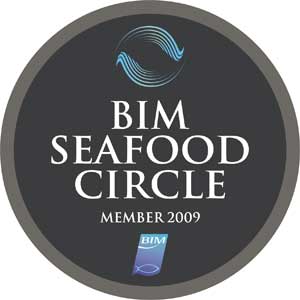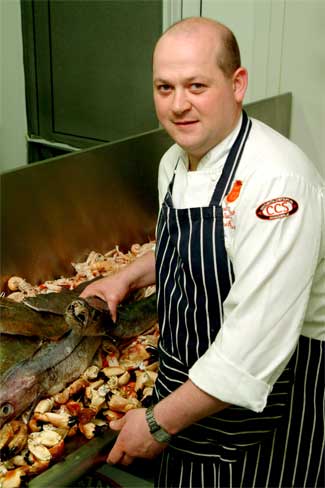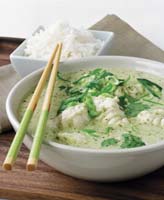Back to our roots - Seafood
 Marilyn Bright chats to BIM Seafood Circle members and discovers their love for the lesser known species of seafood.
Marilyn Bright chats to BIM Seafood Circle members and discovers their love for the lesser known species of seafood.
From Dean Swift’s Malahide herrings “soft as custard” and Molly Malone’s cockles and mussels, history abounds with the variety of Irish seafood enjoyed over the centuries. Through the years, annual shoals of mackerel and herring were celebrated in song and busy fishmongers’ stalls sold plentiful whiting, cod, haddock and hake as well as the dried ling and good red herrings used to flavour the potatoes down the country.
Today the likes of chilli peppers, lemon grass and coriander have expanded our traditional range of ingredients, but when it comes to fish, Irish cooks tend to use fewer types of seafood than their grandparents or the generations before them.
Although there are more than 50 species of edible fish and shellfish caught in local waters, just two species – salmon and cod – dominate menus and account for 60% of sales.
 In Liscannor, County Clare, Denis Vaughan of Vaughans Anchor Inn reckons that he and his fellow members of BIM’s Seafood Circle are bucking the trend and putting lesser used fish back on the menu. With daily landings on the pier opposite Vaughan’s front door, Denis says that “there isn’t any fish I haven’t used.” Gurnard, ling, pollock, even whelks and limpets have appeared on the daily changing menu and Denis’ tip is to introduce less familiar fish by including them on seafood platters combined with favourites like cod, prawns and salmon.
In Liscannor, County Clare, Denis Vaughan of Vaughans Anchor Inn reckons that he and his fellow members of BIM’s Seafood Circle are bucking the trend and putting lesser used fish back on the menu. With daily landings on the pier opposite Vaughan’s front door, Denis says that “there isn’t any fish I haven’t used.” Gurnard, ling, pollock, even whelks and limpets have appeared on the daily changing menu and Denis’ tip is to introduce less familiar fish by including them on seafood platters combined with favourites like cod, prawns and salmon.
Pollock, also known as coley, is a popular choice for fish and chips in many Seafood Circle outlets. The greyish flesh turns white when cooked and as a member of the cod family, pollock can be a cost effective substitute for the more expensive fish in many recipes. Firm enough to be presented as grilled fillets with herb crusted topping, white pollock is as popular as cod in France and experts note that it would challenge the novice to tell the difference from cod in dishes.
White pollock is sometimes called “blossom” by Dubliners, while the black pollock is often sold as smoked coley, attractively priced and a delicious addition to fish pies and chowders or simply poached and served with a buttery sauce and creamy mashed potato. The smoky flavours have a special affinity with eggs as well as cheese, perfect for seafood quiches and flavourful omelettes.
White boardlike fillets of dried salted ling are features of traditional fishmongers’ stalls like O’Connell’s in Cork’s English Market. A useful staple in pre-refrigeration days, it needs soaking and boiling before being combined with potatoes in the time honoured way, or brought up-to-date as Mediterranean style fritters fried in olive oil and served with garlicky aioli. And it’s a good substitute for salt cod (the Spanish bacalao) in a classic brandade, perfect for tapas selections.
 Fresh ling however, is termed “poor man’s cod” by fishmonger–restaurateur Peter Caviston (Cavistons). “It’s half the price and gives a lovely fillet when it’s boned”, he says. Like an increasing number of seafood enthusiasts, Peter is also a champion of the gurnard. Its firm white flesh can be used in the same way as monkfish, and with a similarly large headed body, Peter says the best fillets to use come from the larger fish.
Fresh ling however, is termed “poor man’s cod” by fishmonger–restaurateur Peter Caviston (Cavistons). “It’s half the price and gives a lovely fillet when it’s boned”, he says. Like an increasing number of seafood enthusiasts, Peter is also a champion of the gurnard. Its firm white flesh can be used in the same way as monkfish, and with a similarly large headed body, Peter says the best fillets to use come from the larger fish.
Referring to the premium price now commanded by monkfish, Peter notes that the large heads are usually discarded in processing here. “The monk cheeks are two meaty bits either side of the head and highly regarded in Spain. A good fishmonger will save these for you if you ask”.
Mackerel is one of the most undervalued fish, yet cheap and plentiful at the peak of its summer season and highly recommended as one of the omega rich healthy foods. Freshness is key here and distinguished food writer Jane Grigson says mackerel should be “so fresh that the light shines from it like a rainbow”.
 Mackerel needs a sharp or positive flavour to set off the richness of the deep pink oily flesh. Gooseberries are classic accompaniment, either as sauce or stuffing, and rhubarb works equally well, both benefitting from an added touch of balancing sweetness.
Mackerel needs a sharp or positive flavour to set off the richness of the deep pink oily flesh. Gooseberries are classic accompaniment, either as sauce or stuffing, and rhubarb works equally well, both benefitting from an added touch of balancing sweetness.
Gary Rhodes rolls fresh mackerel fillets around spicy garam masala butter and wraps in caul fat before roasting and serving with red onion and tomato salad. Richard Corrigan (Bentleys) also takes the spice route and slathers mackerel fillets with tamarind and freshly ground spice paste before grilling and serving with sweet potato and lime pickle.
Although plentiful, well-priced and recommended for low-fat diets, whiting is often considered to be the dullest of the cod family, reputation dented by cooks serving up plain steamed fish as invalid fodder or penitential Friday fare. The French regard whiting as one of the most delicately flavoured and finely textured fish, often pairing it with mushrooms and their best white wine and cream sauces. Around the Mediterranean, whiting fillets may be baked with a little olive oil and white wine and finished with orange slices and black olives.
Peter Caviston, who dubs whiting as the “chicken of the sea”, says that bone problems are largely eliminated by choosing larger fish which give good size fillets, and buying from specialist suppliers who know their craft. Skilful fishmongers also remove whiting bones from the back rather than the belly, giving a double fillet butterfly shape for attractive presentation.
The finely textured whiting flesh also makes it perfect for mousseline mixtures, combining well in cost effective versions of luxury dishes like lobster and scallop terrines and quennelles.
Salmon and cod, sole and prawns will always have a place on Irish menus, but more and more caterers are discovering that the sea is an open larder, with a brilliant variety of choices that lend themselves to imaginative dishes and new flavourings – and deliver healthy costings too.






There are currently no comments
Leave a comment
Not a member? Register for your free membership now!
Or leave a comment by logging in with: